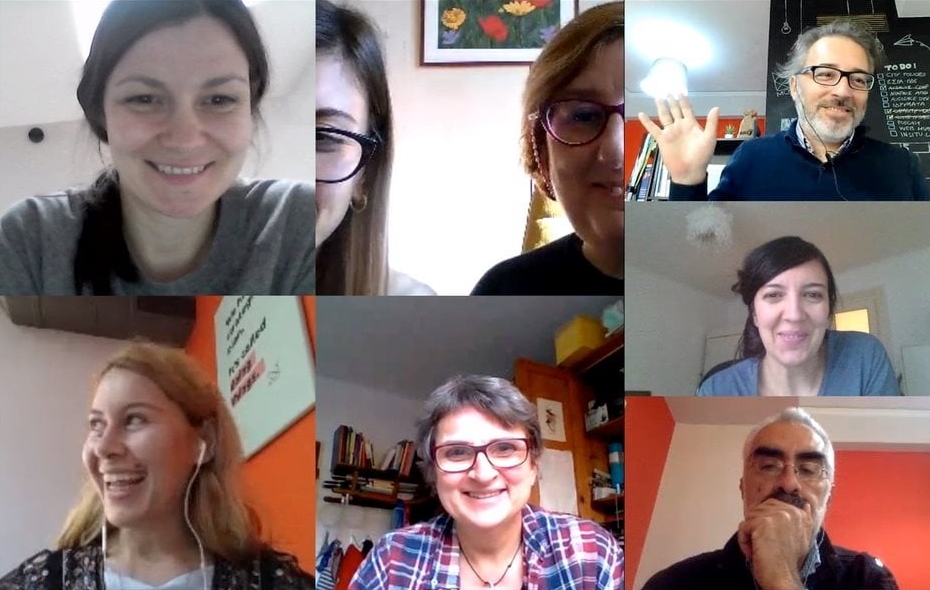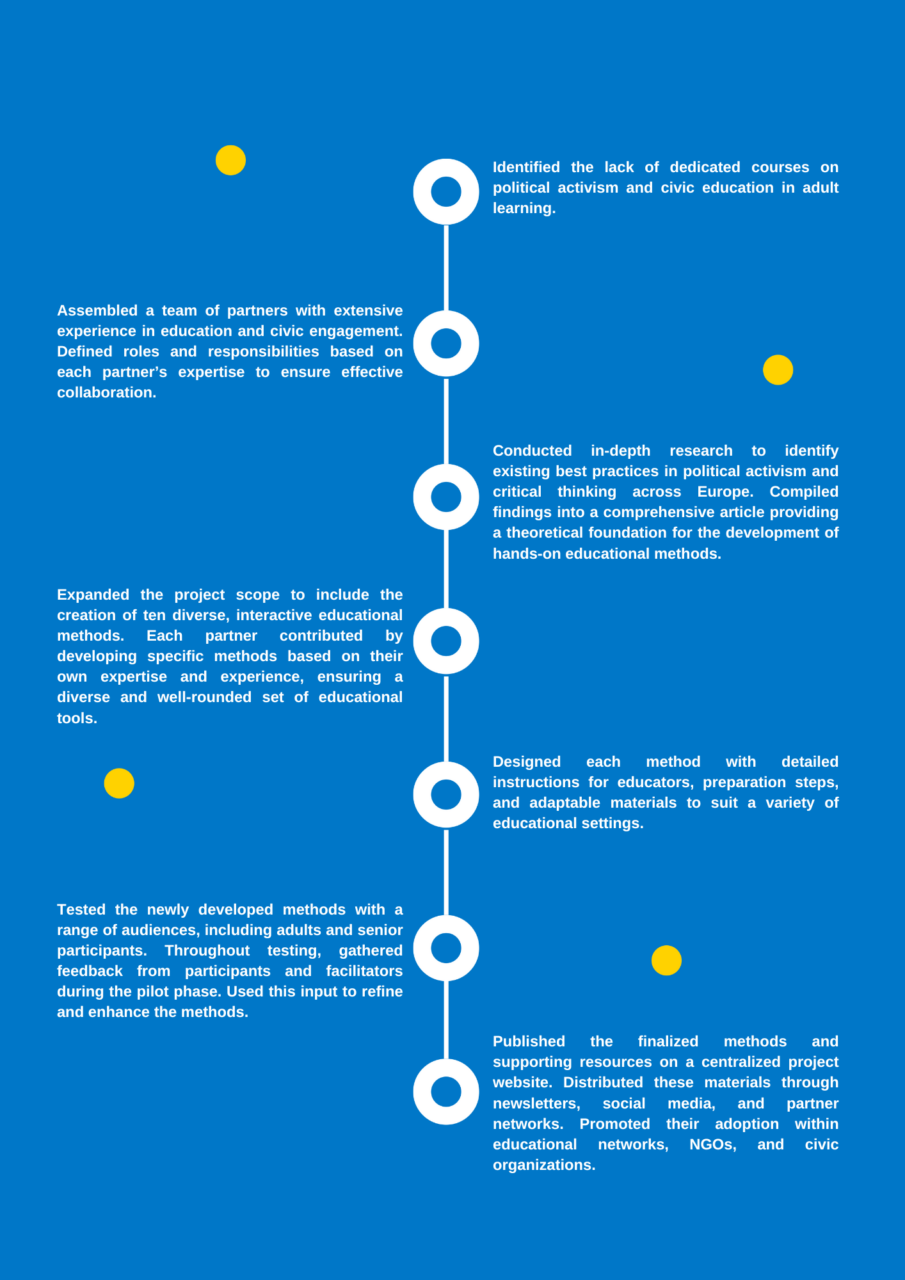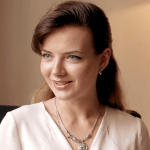By engaging with non-radical political activism and critical thinking, the project supported active citizenship, democratic participation, and social inclusion. The project team succeeded in addressing the needs identified and the issues relevant to the participating organisations and target groups. The transnational exchange on the topic of radicalisation and the collaboration of adult education organisations from European countries with their respective historical and cultural backgrounds brought added value to the adult education landscape. The intertwining of adult education and political education is more exciting than ever!
PACT (Political Activism and Critical Thinking) began as a desk research project with the goal of writing an article about political activism and existing initiatives. It soon evolved into creating a variety of hands-on, interactive methods – such as discussion rounds, roleplay, and exercises in individual reflection – all aimed at teaching political activism in adult education. These methods have since been successfully applied in educational centres, NGOs, and youth organisations.
A lot of people said our methods are super, because they feel so free to use. Traditional learning and concentrating can be boring. Our methods, of course, are also about learning and concentrating, but they have a flow. Afterwards, people feel they have the potential to do something, to change something. This is very important.
We talked to Petra Hauser, author of the PACT project, about her journey to develop innovative teaching methods for activism and critical thinking.
How did the PACT begin, and what were its goals?
The project started in 2020. The idea came when I was talking with another partner, with whom we had previously worked on an entrepreneurship education project. We had noticed that adult education mostly focuses on job skills, while political activism and civic education are often considered to be a part of other subjects. It’s usually only a few hours in a course, not a course on its own. We thought we should do something in this field, especially since we believed that political activism is somewhat similar to entrepreneurship, in the sense that both motivate people to make a change – whether it’s starting a business or joining a citizen’s movement. Initially, we thought about creating a booklet or article about political activism for educators, with a touch of science behind it.
How did that go?
First, we conducted desk research. The project is called Political Activism and
Critical Thinking, so we divided our article into these two sections. We looked for best practices in Europe related to political activism and
critical thinking in fields like sustainability and politics. This research became an article that gives readers a sense of what it is and what has been done in this field so far.
After completing the article, we realised that we could motivate people directly, so we decided to create methods that could be used in various educational courses and could suit different groups and situations.
So you went from desk research to writing educational methods. How did you manage to pull it off?
Each partner developed specific methods. For instance, each of us prepared one method for political activism and one for critical thinking. We tried to incorporate various approaches to engage participants in different ways. Each partner also contributed worksheets to accompany their methods.
Our goal was always to make these methods adaptable to different audiences and accessible across various settings, but we also wanted a consistent structure for each method so that people could follow the same format, regardless of the method they used. For example, each method included a title, aims, preparation steps, process description, references, and links, if needed. We also added charts for target group, duration, setting, and materials, so teachers could easily find methods suited to their needs.
In total, we created 10 diverse methods, including discussion rounds, open letters, and exercises in individual reflection. Other examples are the ‘cinema club debate’ and roleplay ‘Critical Thinking for Survival: Stranded on an Island.’


How did you find partner organisations for the project?
I knew all the partners before starting the project, as I had already worked with them. It was very important to know the partners because, in a project like this, you need to trust each other. For example, our Greek partner was very active in cultural exchange and had programs that encouraged creativity, which was essential because when you’re creating exercises for
critical thinking, you need to think outside the box. And, of course, when we think of political activism and democracy, Greece naturally comes to mind.
Another partner worked in Germany and had extensive experience with democracy-promoting initiatives. They had many contacts with politicians, which allowed us to reach important people who could support the project. They even disseminated our project during their conferences, which was a big boost for us.
Our Italian partner was highly skilled in managing Erasmus projects and had a lot of experience in adult education. They were very strong in quality management and evaluation, which helped us keep everything organised. They also had team members familiar with graphic design, so they helped us present our methods in a visually appealing way. This was really important because, if a method looks outdated or poorly designed, people are less likely to use it.
How did you distribute the results of your work?
We have a website where we uploaded everything – the article, the methods, really everything we did – along with details about us and our partners. We thought that sending an information letter with the links to this website would be the best approach, because it’s hard to explain everything in a small letter. If we sent all the methods directly, people might not open it, so we made it accessible online. We also had a Facebook page, and each partner sent about 100 emails to various organisations, including educational centres, NGOs, and youth organisations, to spread the word further
What were the challenges you faced in implementing the project?
One challenge was presenting the methods to an older audience. They grew up with a different style of learning and often think, ‘Learning is learning, not playing,’ so they aren’t used to doing role plays or games and then reflecting on it. Nonetheless, when we did the ‘Stranded on an Island’ role play with seniors, it really took off at a certain point. They forgot they were in a role play, and at the end, some of them said, ‘I thought role plays were more for children, but I really enjoyed it.’
Our biggest challenge, though, was that the project ran during the COVID pandemic, so everything had to be online. Looking back, I think this actually worked out very well for us. COVID forced us to use online collaboration tools we might not have used otherwise. All these tools – Google Drive, Zoom, and others – allowed us to work together more effectively and faster than before. In the end, I think COVID accelerated things and helped us improve our work approach.
What advice would you give to those interested in similar initiatives?
Critical thinking and political activism are especially important in adult education. Times have changed. My generation grew up with fewer sources of information, so we knew which newspapers or books were trustworthy. Now, information is everywhere, and many people aren’t used to this flood of information, especially on social media, where algorithms push certain ideas. This makes it hard to break out of ‘the bubble’ and means we need to train people to evaluate sources carefully.
For those wanting to start similar projects, I’d say that even small actions can drive change. Learning critical thinking opens the mind and builds resilience against misinformation. My advice is to incorporate these skills into your work – political activism doesn’t have to be big; you can start with small steps. The impact will build over time.
Project Roadmap

Project outcomes
The PACT project has developed a comprehensive set of 10 interactive methods to help educators foster political activism and critical thinking among learners.
Website
A centralised platform for these methods, complete with detailed instructions, objectives, necessary materials, and guides for effective application. All materials are available in five languages: English, German, Greek, Italian, and Serbian.
Article
An in-depth exploration of political activism and critical thinking, providing educators with a theoretical foundation and practical insights into existing initiatives.
About the project
Supported by:
Erasmus+
EU Youth Programme Priority:
Participation in Democratic Life
Visibility:
Official website, hosting 10 interactive methods with detailed guides in five languages (English, German, Greek, Italian, and Serbian), active Facebook page, brochure and postcards, and participation in ErasmusDays 2022.
Organisations involved:












